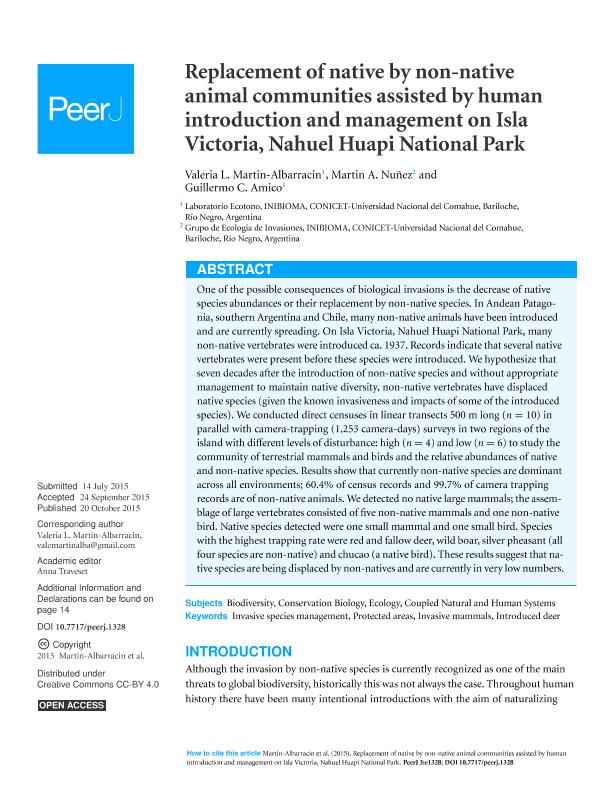Mostrar el registro sencillo del ítem
dc.contributor.author
Martin Albarracin, Valeria Leticia

dc.contributor.author
Nuñez, Martin Andres

dc.contributor.author
Amico, Guillermo Cesar

dc.date.available
2023-01-10T12:15:18Z
dc.date.issued
2015-07
dc.identifier.citation
Martin Albarracin, Valeria Leticia; Nuñez, Martin Andres; Amico, Guillermo Cesar; Replacement of native by non-native animal communities assisted by human introduction and management on Isla Victoria, Nahuel Huapi National Park; PeerJ Inc.; PeerJ; 2015; 10; 7-2015; 1-19
dc.identifier.issn
2167-8359
dc.identifier.uri
http://hdl.handle.net/11336/184079
dc.description.abstract
One of the possible consequences of biological invasions is the decrease of native species abundances or their replacement by non-native species. In Andean Patagonia, southern Argentina and Chile, many non-native animals have been introduced and are currently spreading. On Isla Victoria, Nahuel Huapi National Park, many non-native vertebrates were introduced ca. 1937. Records indicate that several native vertebrates were present before these species were introduced. We hypothesize that seven decades after the introduction of non-native species and without appropriate management to maintain native diversity, non-native vertebrates have displaced native species (given the known invasiveness and impacts of some of the introduced species). We conducted direct censuses in linear transects 500 m long (n = 10) in parallel with camera-trapping (1,253 camera-days) surveys in two regions of the island with different levels of disturbance: high (n = 4) and low (n = 6) to study the community of terrestrial mammals and birds and the relative abundances of native and non-native species. Results show that currently non-native species are dominant across all environments; 60.4% of census records and 99.7% of camera trapping records are of non-native animals. We detected no native large mammals; the assemblage of large vertebrates consisted of five non-native mammals and one non-native bird. Native species detected were one small mammal and one small bird. Species with the highest trapping rate were red and fallow deer, wild boar, silver pheasant (all four species are non-native) and chucao (a native bird). These results suggest that native species are being displaced by non-natives and are currently in very low numbers.
dc.format
application/pdf
dc.language.iso
eng
dc.publisher
PeerJ Inc.
dc.rights
info:eu-repo/semantics/openAccess
dc.rights.uri
https://creativecommons.org/licenses/by/2.5/ar/
dc.subject
INTRODUCED DEER
dc.subject
INVASIVE MAMMALS
dc.subject
INVASIVE SPECIES MANAGEMENT
dc.subject
PROTECTED AREAS
dc.subject.classification
Ecología

dc.subject.classification
Ciencias Biológicas

dc.subject.classification
CIENCIAS NATURALES Y EXACTAS

dc.subject.classification
Conservación de la Biodiversidad

dc.subject.classification
Ciencias Biológicas

dc.subject.classification
CIENCIAS NATURALES Y EXACTAS

dc.title
Replacement of native by non-native animal communities assisted by human introduction and management on Isla Victoria, Nahuel Huapi National Park
dc.type
info:eu-repo/semantics/article
dc.type
info:ar-repo/semantics/artículo
dc.type
info:eu-repo/semantics/publishedVersion
dc.date.updated
2023-01-06T09:29:53Z
dc.journal.volume
2015
dc.journal.number
10
dc.journal.pagination
1-19
dc.journal.pais
Reino Unido

dc.description.fil
Fil: Martin Albarracin, Valeria Leticia. Consejo Nacional de Investigaciones Científicas y Técnicas. Centro Científico Tecnológico Conicet - Patagonia Norte. Instituto de Investigaciones en Biodiversidad y Medioambiente. Universidad Nacional del Comahue. Centro Regional Universidad Bariloche. Instituto de Investigaciones en Biodiversidad y Medioambiente; Argentina
dc.description.fil
Fil: Nuñez, Martin Andres. Consejo Nacional de Investigaciones Científicas y Técnicas. Centro Científico Tecnológico Conicet - Patagonia Norte. Instituto de Investigaciones en Biodiversidad y Medioambiente. Universidad Nacional del Comahue. Centro Regional Universidad Bariloche. Instituto de Investigaciones en Biodiversidad y Medioambiente; Argentina
dc.description.fil
Fil: Amico, Guillermo Cesar. Consejo Nacional de Investigaciones Científicas y Técnicas. Centro Científico Tecnológico Conicet - Patagonia Norte. Instituto de Investigaciones en Biodiversidad y Medioambiente. Universidad Nacional del Comahue. Centro Regional Universidad Bariloche. Instituto de Investigaciones en Biodiversidad y Medioambiente; Argentina
dc.journal.title
PeerJ
dc.relation.alternativeid
info:eu-repo/semantics/altIdentifier/url/https://peerj.com/articles/1328/
dc.relation.alternativeid
info:eu-repo/semantics/altIdentifier/doi/http://dx.doi.org/10.7717/peerj.1328
Archivos asociados
